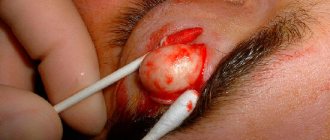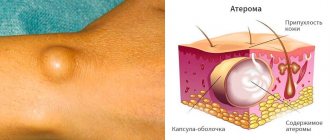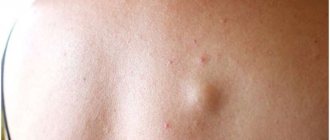The occurrence of atheroma is a very common pathological process. It has no age restrictions or gender – it affects both children and adults of both sexes equally. Atheroma is a modification in the sebaceous gland that occurs during blockage of its own duct. The accumulating glandular secretion forms a subcutaneous capsule-shaped formation, separated from healthy tissue by a rough connective membrane.
Rice. 1. Atheroma is a cyst of the sebaceous gland.
Characteristic differences of atheroma.
Atheroma has a number of characteristic features by which it is quite easy to distinguish it from other skin formations:
- atheroma always has a clear round shape;
- upon palpation, the atheroma always moves inextricably along with the thickness of the skin; it is not possible to move it separately;
- atheroma is pliable, soft to the touch;
- in the absence of inflammation in the atheroma, touch does not cause discomfort or pain.
Rice. 2. Atheroma during removal.
Symptoms, diagnosis and treatment
In the early stages of atheroma on the back
does not cause any discomfort, so it is most often detected by accidental touch. This formation has a yellowish surface and is mobile. The size of the cyst can vary from a few millimeters to 6 cm.
The main symptoms, upon the appearance of which it is necessary to immediately call a surgeon to your home or visit the clinic, are the addition of a secondary infection. The tumor becomes swollen and painful, and the skin takes on a red tint. There is also an increase in temperature at the site where the atheroma is located. A grayish substance with an unpleasant odor may also be released. In advanced cases, malaise and general weakness and increased body temperature will occur.
During the initial consultation, the doctor examines the patient and palpates the formation, and also prescribes certain studies for differential diagnosis. As for the treatment of atheroma, it can be carried out in several ways:
The surgical method is considered traditional. It is performed using local anesthesia and involves excision of the cyst capsule. When inflammation occurs, the atheroma is opened, the wound is washed and, if necessary, drained;
Laser therapy is less traumatic. However, the surgeon can prescribe it only in the initial stages of the disease.
The radio wave method is considered the safest, since its use does not involve incisions or punctures of the skin.
Useful information on the topic:
- Calling a surgeon to your home
- Callus
- Abscess on finger
- Ingrown nail
- Felon
- Wart removal
- Removal of condylomas
- Abdominal ultrasound
- Removal of papillomas
- Treatment of bedsores
- X-ray
- Removing stitches
- Gastroscopy
- Colonoscopy
The appearance of atheroma, why does this happen?
Among the causes of atheroma, there are several main ones:
- insufficient skin care - with prolonged accumulation of dirt particles mixed with sweat in the thickness of the skin, blockage of the glandular duct is possible, which leads to the formation of atheroma;
- systematic injury to the skin - causes detachment of skin cells that prevent the outflow of glandular secretions;
- hormonal imbalance – this especially applies to sex hormones;
- excessive sweating;
- poor environmental situation.
Rice. 3. Squeezing out atheroma is not recommended.
Types of neoplasm
Atheroma is a cyst of the excretory ducts of the sebaceous glands. The division of tumor types is carried out according to histomorphological structure:
- Epidermal type
Occurs in exceptional cases and is formed from epithelial skin cells. The pathology occurs in the embryonic period and is associated with the proliferation of the epithelium. The resulting cyst is filled with elements present in sebum and keratin.
This variety is characterized by slow growth and development and is found in women. The tumor develops under the hair on the head, in the groin area in women or on the genitals in men.
- Retention type
The formation of a neoplasm occurs when the excretory ducts of the sebaceous gland are blocked. The tumor grows faster and occurs equally often in men and women. Atheroma forms on the skin of the chest, face, in the external genital area or under the hair on the head.
Neoplasms of this type develop singly or multiplely, in most cases they have the same size. They are capable of merging into a common formation and can become inflamed under the influence of individual factors.
An additional division into types is associated with the origin of atheroma. Experts highlight:
- primary or true - refers to congenital anomalies, formed during embryonic development;
- secondary or false - an acquired neoplasm, occurs under the influence of blockage of the sebaceous gland and problems with secretion, leading to the formation of a capsule with altered sebum.
Regardless of the type of atheroma present, the only treatment is surgical removal of the tumor.
Symptoms of atheroma.
Since the disease itself is not inflammatory in nature, it also has no general manifestations. Non-festering atheroma is locally manifested only visually - as a skin tubercle, while the color and skin pattern remains unchanged.
Rice. 4. Atheroma occurs due to blockage of the sebaceous gland duct in the skin.
General information about atheroma and its location
A benign tumor of the dermis is registered in 10% of patients, mainly in women over 30 years of age. Atheroma is often combined with seborrhea and acne. A neoplasm is formed on the skin with a large number of sebaceous glands: in the area of the head, mammary glands, back or face. The tumor reaches 1-5 cm, sometimes there are varieties with large sizes.
The pathological process affects different areas:
- scalp and back;
- cheeks, forehead, chin;
- earlobes or auricles;
- back, side surface of the neck;
- breast.
Less commonly, you can find atheroma on the lower extremities, genitals, in the groin area, in the area of the labia or scrotum.
Neoplasms are represented by pronounced cosmetic defects that provoke psychological discomfort in patients. Patients often turn to surgeons to remove tumors. Operations are carried out due to the risk of infectious pathogens entering the capsule and subsequent suppuration of the atheroma. The contents of the neoplasm are considered a favorable environment for the proliferation of bacteria and subsequent inflammation with the formation of cavities filled with pus.
The suppuration of tumors is caused by various mechanical injuries to the sites of their formation. In most cases, the cause of the appearance of pus in the capsules cannot be determined, which leads to the diagnosis of “purulent idiopathic atheroma.”
Suppuration of atheroma, what causes inflammation?
The only reason for atheroma suppuration is the entry of microorganisms into the atheroma capsule. They penetrate there, most often during independent attempts to get rid of atheroma or during injuries. Atheromas in the facial area are often mistaken for small pimples and when you try to squeeze them out, pathogenic bacteria penetrate inside. The inflammatory process in atheroma manifests itself as pain in the area where the process is localized, changes in the color of the skin and the size of the formation. Very often, a suppurating atheroma can rupture on its own; in such cases, it is necessary to apply a bandage to the damaged area and immediately seek medical help.
Festering atheroma
A large number of opportunistic microorganisms live on the surface of the skin. Usually these are bacteria from the groups:
- staphylococci;
- streptococci;
- peptococci;
- coli.
But with sufficiently active immunity, the proliferation of microorganisms is inhibited. When the immune defense is weakened, bacteria penetrate into the cavity of the cyst, and its contents become a breeding ground for them.
Suppurating atheroma is a complication that requires urgent surgical care. An abscess forms at the site of the cyst. This is accompanied by a deterioration in the general condition, malaise, pain in the area of the atheroma, its swelling and hyperemia. Inflamed atheroma can lead to the formation of an abscess, and in advanced cases, when pus breaks through into the subcutaneous tissue, phlegmon forms.
Treatment of atheroma.
Regardless of how the process proceeds acutely (with inflammation) or sluggishly (without suppuration), atheroma can be treated through surgery. If there are no inflammatory manifestations in the atheroma, the time of the operation can be agreed separately with the doctor. If there is suppuration, the operation occurs urgently - urgently. If atheroma is detected, you should not delay contacting a specialist, since this pathology has a huge tendency to grow. Self-medication of atheroma is excluded and can be dangerous to your health.
Is it possible to open atheroma and treat it at home?
Traditional methods of treatment against atheroma are ineffective. Local exposure using herbal decoctions and alcohol infusions is not effective; it will not help empty the cyst and eliminate the capsule, which becomes a source of re-development of the formation.
You cannot open the atheroma yourself at home. It is impossible to provide a sufficient level of asepsis and sterile surgical instruments outside the conditions of a medical institution. Treatment under such conditions can lead to infection and the development of complications. Atheroma will result in the formation of an abscess or phlegmon. It is especially dangerous if you open an atheroma on the face or head.
Rehabilitation
The rehabilitation period depends on the type of procedure. So, the longest recovery period is after surgery (8-10 days). If the operation had to be done urgently, only to clear the atheroma for subsequent surgical intervention, then the healing period is about 3 months - only after this period can you consult a doctor again for surgery.
The patient needs to treat the wound after removal of the atheroma for 2-3 days, and after 7 days come to remove the sutures. The doctor may also prescribe antibiotics (depending on the severity of the situation).
After laser treatment and radio wave treatment, antibiotic treatment is usually not required, since these instruments disinfect the affected area. The recovery period in both cases is 2-3 days, and another advantage is that there are no scars left after them.
Symptoms of atheroma
Before seeking advice from a specialist, patients often compare photos of atheroma on the Internet with their condition.
The main symptoms of the pathology include:
- changes in the structure of the skin;
- the appearance of a dense formation;
- When infected, swelling, pain, and fever may appear.
A photo of atheroma on the head clearly shows what the formation looks like. It has a flat, smooth surface and rises greatly above the surface of the skin.
If you experience similar symptoms, consult your doctor
. It is easier to prevent a disease than to deal with the consequences.
Causes of atheroma
Atheroma is a formation in which a cosmetic defect occurs along with unpleasant sensations. The cause is a variety of factors:
- swelling of the hair follicle;
- metabolic disease;
- blocked ducts;
- injury;
- hyperhidrosis;
- hormonal imbalance.
Also, the disease can occur if personal hygiene rules are not followed; for example, atheroma on the head often forms for this very reason. Removing atheroma allows you to completely get rid of the problem.
Methods for removing atheroma
The following methods are used in medicine:
- surgical intervention;
- laser therapy;
- radio wave method.
For this purpose, the most modern techniques are used, guaranteeing an excellent cosmetic effect, reducing the risk of complications and recurrence of the disease to a minimum.
The choice of therapy depends on complications and the size of the cyst. So, if it is not complicated and surgical intervention is chosen, then the doctor cuts the skin and completely removes the atheroma along with the contents and capsule. The procedure is performed under local anesthesia; the puncture minimizes the risk of scar formation after surgery. If the cyst is complicated by suppuration or inflammation, then surgical intervention is carried out in two stages:
- The surgeon opens the abscess and removes the contained mass.
- The doctor eliminates the tumor capsule, which minimizes the risk of re-infection.
As for laser removal of atheroma, it has the advantage of being minimally invasive. This is a modern method, which is carried out only in cases where the cyst is small and always under local anesthetic. After such manipulation, the wound heals faster, there are no stitches, and scars, as a rule, do not appear. In addition, the procedure takes a minimum amount of time.
The last of the methods presented involves the impact of radio waves on the affected areas without affecting healthy tissue. The most important advantage of the manipulation is the shortest recovery period (2-3 days). Also, there are no scars left after the procedure.
If the situation is very advanced (severe inflammation, abscess or infection), then an emergency surgical operation is performed to remove the atheroma, in which the tumor is not removed, but only cleaned. The elimination procedure is carried out only after healing, the period of which is on average 3 months. After the procedure, the patient may be prescribed antibiotics (depending on his initial condition).
Surgical
Surgery is performed if the cyst is large or there is inflammation.
Before the operation, local anesthesia is administered, after which the doctor makes an incision in the membrane of the cyst. If the atheroma has a hole, two such punctures will be needed. After this, the surgeon cleans the capsule cavity. If there is pus, then cleaning is carried out with special care - the walls of the cyst must not be allowed to rupture. After the manipulations, the capsule is completely cut.
After the procedure, the doctor stitches and treats the wound. In case of surgical removal of atheroma, suture removal must be ensured on the 7th day after surgery.
The recovery period after manipulation is from 8 to 10 days, during which it is necessary to wear a sterile dressing to prevent infection of the wound, for which it is necessary to treat the postoperative area with disinfectants for 2-3 days. Antibacterial treatment may also be needed.
It should be borne in mind that in case of severe inflammation, abscess or infection, emergency surgery is performed, during which only cleaning is performed. The healing period in this case increases to 3 months, after which time a planned operation is performed according to the above algorithm.
Radio wave
The radio wave method is one of the most popular because it provides an excellent cosmetic effect without leaving scars. For this manipulation, a special radio wave scalpel is used, which affects the tissue with high-frequency current. It is needed in order to simultaneously cut the tissue and carry out coagulation.
Among the main advantages of radio wave removal of atheroma:
- the risk of recurrence of the disease is minimized;
- short recovery period (2-3 days);
- once the procedure is completed, the patient can return to their normal lifestyle;
- excellent cosmetic effect;
- the scalpel does not touch healthy tissue;
- no bleeding due to coagulation.
As for the duration, it averages 20-30 minutes. At the end of the procedure, a small soft tissue defect remains.
The operation is carried out as follows: first, local anesthesia is given, after which the doctor burns out the atheroma from the inside with an instrument.
Laser removal of atheroma
Laser tumor correction is used when the cyst is small in size. This procedure uses a CO2 laser to vaporize the cyst using high temperature without affecting adjacent tissue. As in the case of the radio wave method and surgery, local anesthesia is used.
Among the advantages of eliminating atheroma using a laser are:
- the instrument does not touch adjacent healthy tissue;
- thanks to the coagulating effect, the operation takes place with minimal bleeding;
- the method is non-contact, which prevents infection;
- the risk of relapse is minimized;
- There are no scars left at the site where the atheroma was removed with a laser.
The duration of the operation, as a rule, does not exceed 30 minutes.










